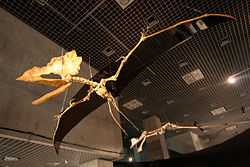Thalassodromeus
| Thalassodromeus Temporal range: Early Cretaceous, 108Ma | |
|---|---|
 | |
| Restored skeleton | |
| Scientific classification | |
| Kingdom: | Animalia |
| Phylum: | Chordata |
| Order: | †Pterosauria |
| Clade: | †Neoazhdarchia |
| Family: | †Thalassodromidae |
| Genus: | †Thalassodromeus |
| Species: | † T. sethi |
| Binomial name | |
| Thalassodromeus sethi Kellner & Campos, 2002 | |
Thalassodromeus was a large pterodactyloid pterosaur found in northeastern Brazil.
The genus was named in 2002 by Alexander Kellner and Diogenes de Almeida Campos. The type species is Thalassodromeus sethi. The genus name is derived from Greek thalasse, "sea" and dromaios, "runner", in reference to its presumed life style as a skimmer. The specific name refers to the Egyptian god Seth because of the similarity in head form. In 2006 André Jacques Veldmeijer suggested Kellner had confused Seth with the god Amun whose crown shows a remarkable resemblance with the Thalassodromeus head crest.[1]


The genus is based on holotype DGM 1476-R, a damaged partial skull, found in the Santana Formation. Thalassodromeus lived in the Early Cretaceous, roughly 108 million years ago. It shared the skies with its smaller cousin Tapejara. It is particularly notable for its immense head crest, beginning at the tip of the snout and ending far behind the braincase, which accounts for seventy-five percent of the surface of its 1.42 metre (4.6 ft) long skull. The jaws were pointed and toothless. It had a wing span of roughly 4.5 metres (14.7 ft).[2] The function of the crest is unknown, but it may have been used for sexual display, species recognition, or thermoregulation. A lower jaw fragment referred to Thalassodromeus, DGM 1476-M, indicates a larger example with a wingspan of 5.3 metres (17.4 ft). Another jaw fragment, SAO 251093, was unofficially suggested to be a new species, "Thalassodromeus oberli" (referring to the Urbs Oberli collection), by Veldmeijer, but he later reversed this opinion and referred the specimen to T. sethi.[3]
Thalassodromeus was believed by Kellner to have fed in a similar way to modern skimmers; trailing its lower jaw in the water while it flew. However, later research on its jaw and neck anatomy suggested that for this and other larger pterosaurs it would not be feasible to skim because of the drag: the energy expenditure would be too high.[4] Rather, Thalassodromeus appears to have had specialisation for terrestrial foraging like azhdarchids, even converging on leg proportions, and it's powerful jaws might suggest raptorial tendencies akin to those of phorusrhacids.[5]
Kellner assigned Thalassodromeus to the Tapejaridae. Other analyses however, showed that it was, joined with Tupuxuara in a Thalassodrominae, more closely related to the Azhdarchidae.
See also
- List of pterosaurs
References
- ↑ Veldmeijer, A. J. (2006). Toothed pterosaurs from the Santana Formation (Cretaceous; Aptian–Albian) of northeastern Brazil, Proefschrift Universiteit Utrecht. p. 1-269
- ↑ Kellner, A. W. A., and Campos, D. A. (2002). "The function of the cranial crest and jaws of a unique pterosaur from the early Cretaceous of Brazil." Science, 297 (5580): 389-392. (19 July 2002).
- ↑ Veldmeijer, A.J. (2005). "Pterosauriërs uit Brazilië, een overzicht van de soorten met een gebit." Straatgras, 17(3): 45-48.
- ↑ Stuart Humphries, Richard H. C. Bonser, Mark P. Witton, David M. Martill (2007). "Did Pterosaurs Feed by Skimming? Physical Modelling and Anatomical Evaluation of an Unusual Feeding Method", PLoS Biol 5(8): e204. doi:10.1371/journal.pbio.0050204 http://biology.plosjournals.org/perlserv/?request=get-document&doi=10.1371/journal.pbio.0050204
- ↑ Pterosaurs: Natural History, Evolution, Anatomy, Mark P. Witton